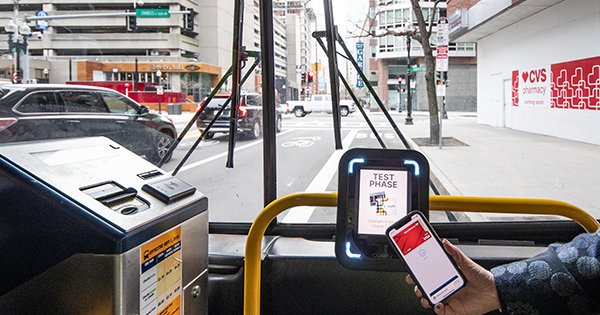BU students welcome a contactless fare system that makes for easier riding, but fare evaders will have to start paying
Forgot your Charlie Card? No cash on hand? By the end of the summer you should be able to pay for your MBTA Green Line ride with a wave of your phone or your debit or credit card, like almost everything else in your daily life.
The MBTA says its new contactless fare collection system will be in place for subways, trolleys, and buses by the end of the summer, albeit years behind schedule and millions over budget. And the new system may end the common practice of passengers boarding a trolley at the rear door and skipping the fare box.
Some Boston University students who ride the B Line regularly up and down campus believe that it will streamline their commute and make it more convenient, while others are concerned about the cost.
“I always lose my Charlie Card or have no funds remaining on it, which is a bit of a hassle,” Lauren Chung (COM’27) says. “If the T were to use contactless payments, it would be so much more convenient, especially because I don’t have my wallet on me all the time.”
If the T were to use contactless payments, it would be so much more convenient, especially because I don’t have my wallet on me all the time.
And from Ellen Zheng (ENG’27): “I’m moving off campus next semester to a location that would likely require me to take the T every day to campus. I am not looking forward to needing to pay $4.80 every day just to go to class.”
New fare collection devices began turning up on trolleys and at subway station turnstiles for testing last year. When asked when the new system will be used on the Green Line, an MBTA spokesperson said the T is still finalizing details and cannot yet announce a launch date.
If it’s good news for the vast majority of commuters, it’s bad news for fare evaders: the small, tablet-like devices are installed on all doors of trolleys and buses, and the T is hiring and training 16 “fare engagement officers,” who will take to the rails in the next few months to “educate riders” about the new system, according to T officials. After six months, they will begin issuing warnings and writing tickets for those who don’t pay, with fines of $50 to $100 for subsequent offenses. Those cited will be able to appeal the fines based on the facts or financial hardship, the T says.
In theory, at least, that’s good for those who always pay when they ride.
“I think it’s better that everyone gets charged to use the T,” Rohan Banerje (CAS ’26) says. “Otherwise, the quality of the T will just get worse, because I’m presuming that the money is being used to maintain the T and public transit in general.”
Not everyone agrees.
“I never really felt bad about not paying for the T,” Rishabh Gokarn (Sargent’25) says. “The T is always off schedule, so we’ll see if they even make it happen this summer.”
“I see the value from the city’s view, since it is a service that costs money to maintain and run,” says Treshan Nilaweera (Questrom’27). “But I’m also not happy about having to pay for a service I was once able to access for free.”
Riders will continue to be able to use a Charlie Card or cash, at least for the time being. The only part of the subway/trolley system that won’t be using the new fare collection system yet is the Mattapan leg of the Red Line, where work will start later this year.
Still being hashed out are concerns about data collection and privacy with the new system, along with community questions about enforcement bias—whether the new system will unduly burden underserved communities.
“While $2.40 seems like a small amount, for someone who is working or takes the T to and from class once a day, that means they spend $4.80 per day on transport, say five days a week,” says Benjamin Brosnahan (CAS’27). For someone who does that every day, that adds up to $96 a month. “While this sucks for me as a college student,” he says, “I suspect it’s much worse for people who actually really rely on the T for their employment, and are lower income.”
The $700 million dollar project was awarded to San Diego–based Cubic Corporation back in 2018, and it was supposed to be finished in 2021, but met repeated delays. In late May, T officials told their board of directors that the system will be fully operational by 2026, when commuters will be able to use their phones and cards on commuter rail trains and ferries as well. The projected final cost: $926 million. But that’s down from the $967 million originally projected when the delays were figured in, according to the presentation to the board.
BU students also proposed several potential solutions to improve the situation, taking inspiration from existing cities around the world. One student suggested implementing gates at aboveground stops as seen in tram stations in Turkey. Another idea centered around making public transportation more accessible for students through financial assistance.
Carl Larson, BU Sustainability assistant director of Transportation Demand Management and Planning, says that the University does not subsidize passes for its students. However, he says, “BU facilitates the purchase of discounted MBTA Semester Passes. These are really best for students living off campus who commute on the T most days. We also fund and manage a frequent-service, four-line shuttle system [BU Shuttle/the BUS] that connects our campuses and provides late night service until well after the T has stopped running seven days a week.”











